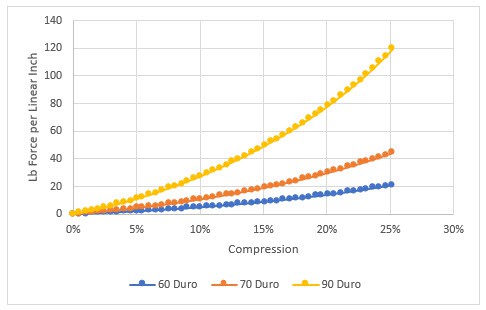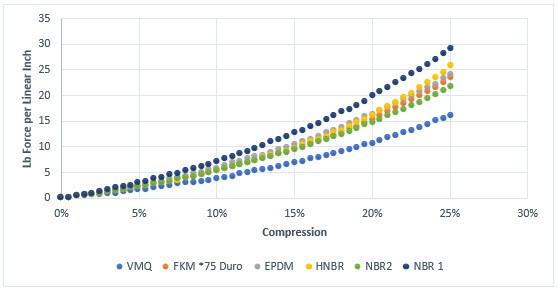5 Factors to Consider When Determining Compressive Load of a Seal
Closure force requirements are an important consideration for sealing applications, and the Applications Engineering team is often asked for guidance as to how to minimize or predict the amount of force it will take to close a properly-designed face seal groove.
There are several factors to consider when trying to determine the compressive load. The most important of those considerations are:
- What is the hardness of the rubber (durometer)?
- How much will the O-Ring be compressed?
- What is the cross-sectional thickness of the O-Ring?
- How wide is the groove?
- What impact does material family play?
Hardness of the rubber
It is correct to assume that as the hardness of the rubber increases so too does the compressive load. Parker’s O-Ring and Engineered Seals Division offers materials that cover a range of 40-95 durometers (Shore A scale).
Below is an example of compressive load for a 0.139” CS O-ring made from NBR (Buna-N) materials at different measures of hardness (60, 70, and 90):
Figure 1: Measure of compressive force requirements of a 0.139” CS, NBR material at different hardness levels.
Cross-sectional thickness
Another intuitive thought is that as cross-section diameter increases, so does the compressive load requirement.
Below is a plot of compressive load requirements per linear inch for the standard cross-sections (0.070”, 0.103”, 0.139”, 0.210”, and 0.275”), and it follows that logic.
Figure 2: Compressive load requirements at different cross-sectional thicknesses on a 70 durometer NBR material.
Groove width
Groove width impacts compressive load because of how it changes the amount of gland-fill in a given application. If a groove is narrow, the O-ring is likely to make sidewall contact once compressed. When sidewall contact occurs, it results in higher compressive load requirements because of how the part is being constricted in the groove. If there is an application that has high gland fill, adding a draft angle can significantly reduce the compressive load requirements, as shown in Figure 3. Figures 4, 5, and 6 show the impact of groove width and draft angle on gland fill.
Figure 3: Compressive force for 0.070″ CS 70 Durometer NBR at 99.8% nominal gland fill when fully compressed. The graph shows the impact of the draft angle on the compressive load for grooves that have very high gland fill.
Figure 4: This image shows an O-Ring being compressed with no sidewall contact.
Figure 5: This image shows an O-Ring being compressed the same amount as in Figure 4, but with a narrower groove. The result is a very high gland fill.
Figure 6: This is the same amount of compression as in Figure 5, but with a 3-degree draft angle added. The result is lower gland fill and lower stress on the O-Ring.
Material family
A common myth in the sealing industry is that there is a correlation between material family and compressive load requirements, but as seen in the graphic below, that is not necessarily the case. The only truly accurate statement is that silicone materials have lower compressive load requirements than that of other materials. Otherwise, many material families have a significant overlap in the amount of compressive load they generate for the same amounts of the squeeze.
Below is a plot of compressive load requirements per linear inch for various 70 durometer materials.
Figure 7: Compressive load requirements by a material family with hardness held at 70 durometers.
In summary, here are some ways to mitigate high compressive loads without sacrificing the amount of squeeze applied to the seal:
• Use a softer (lower durometer) material.
• Use a thinner cross-sectional diameter.
• If gland fill is very high, widen the groove. If that is not possible, consider adding a draft angle.
• If appropriate for the application, switch to a silicone seal material.
• If the application is conducive, consider using a hollow cross-section from our extruded product line.
An overview of our electrically conductive elastomer seals incl. data sheets can be found here.
We will be happy to help you with the selection or advise you which material makes the most sense in your case. Please feel free to contact our team directly here!











